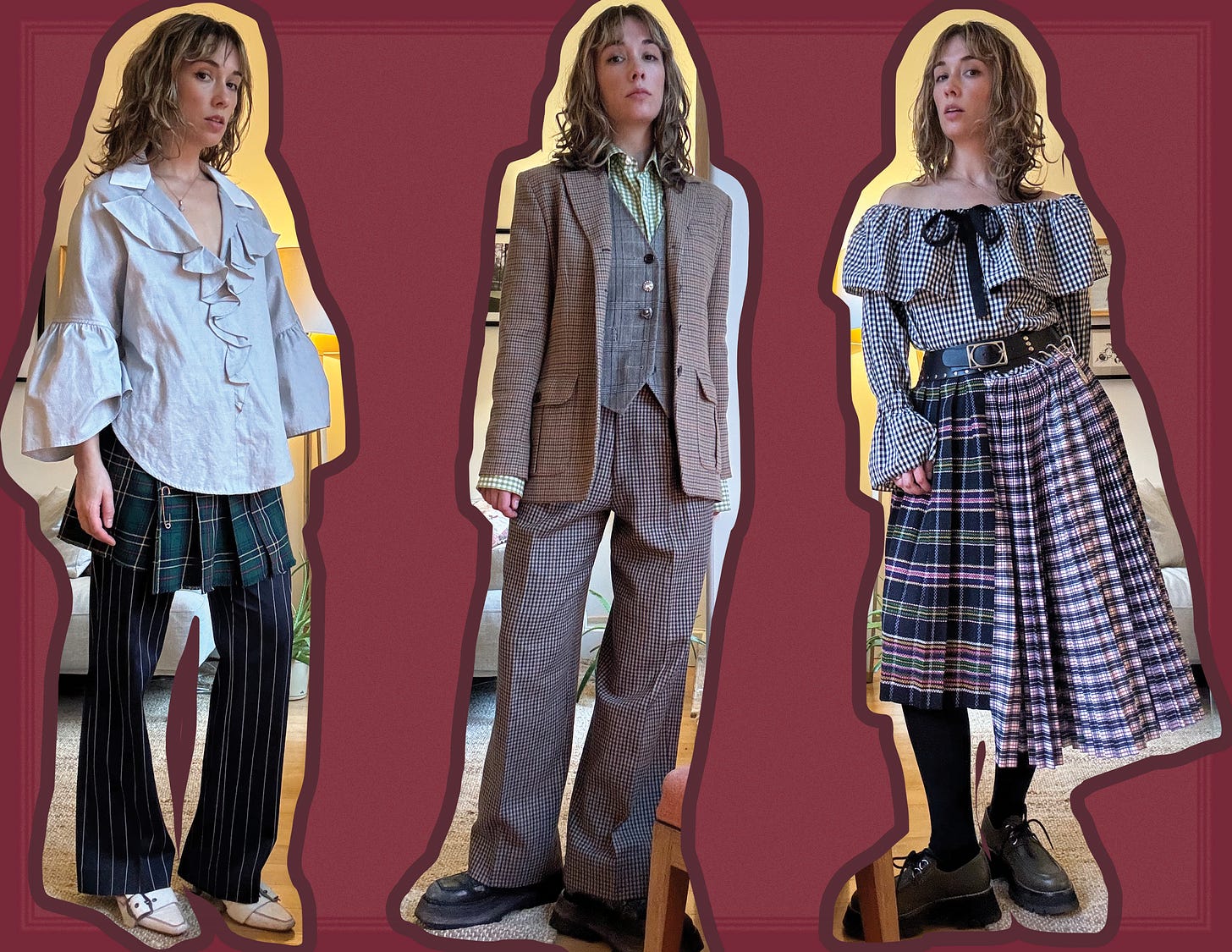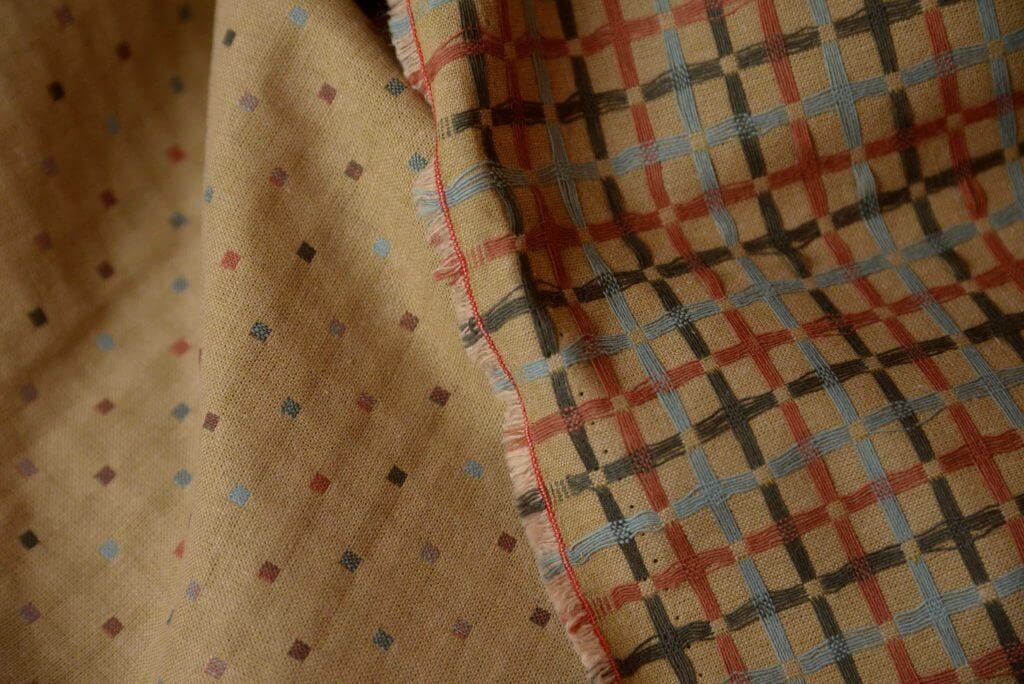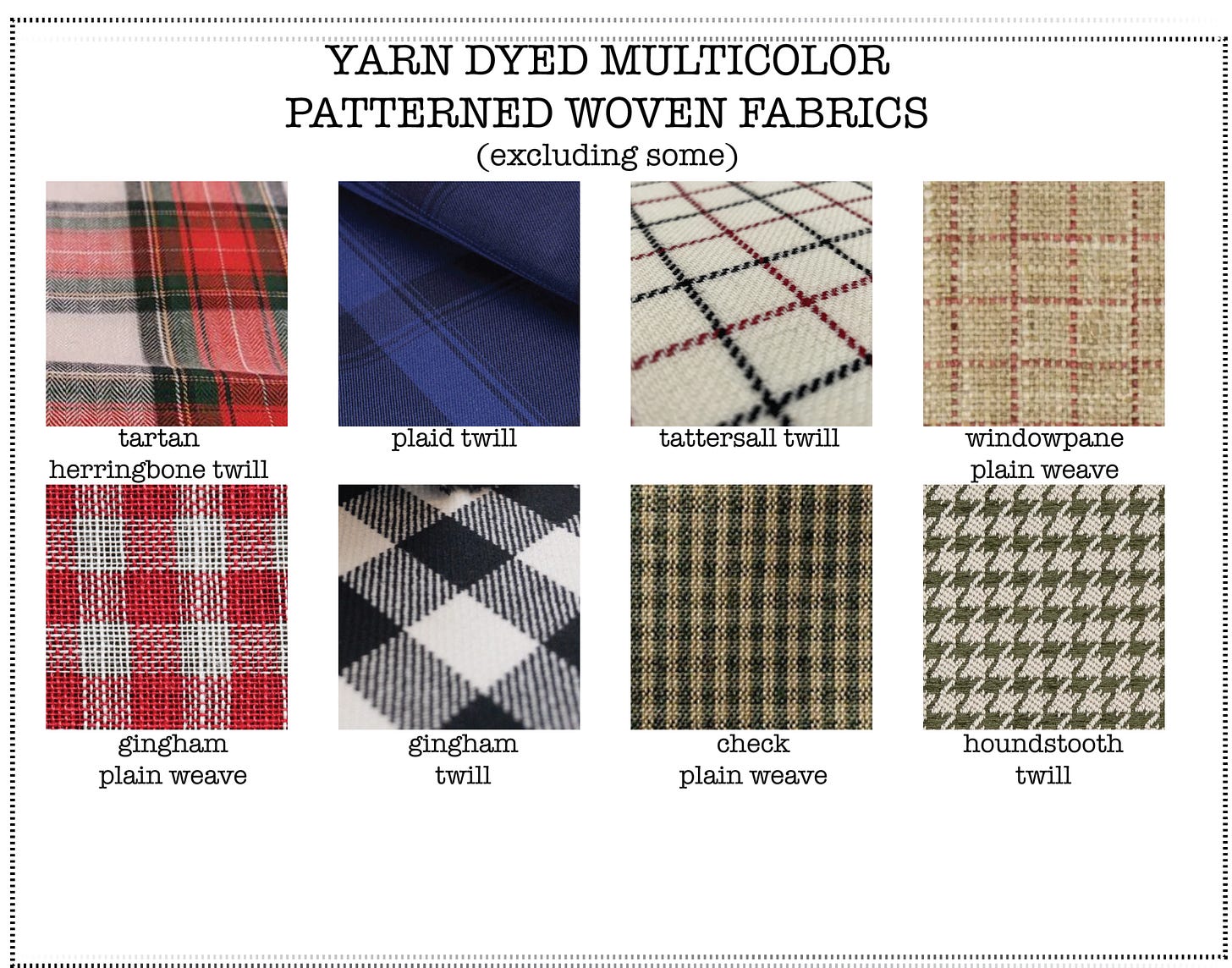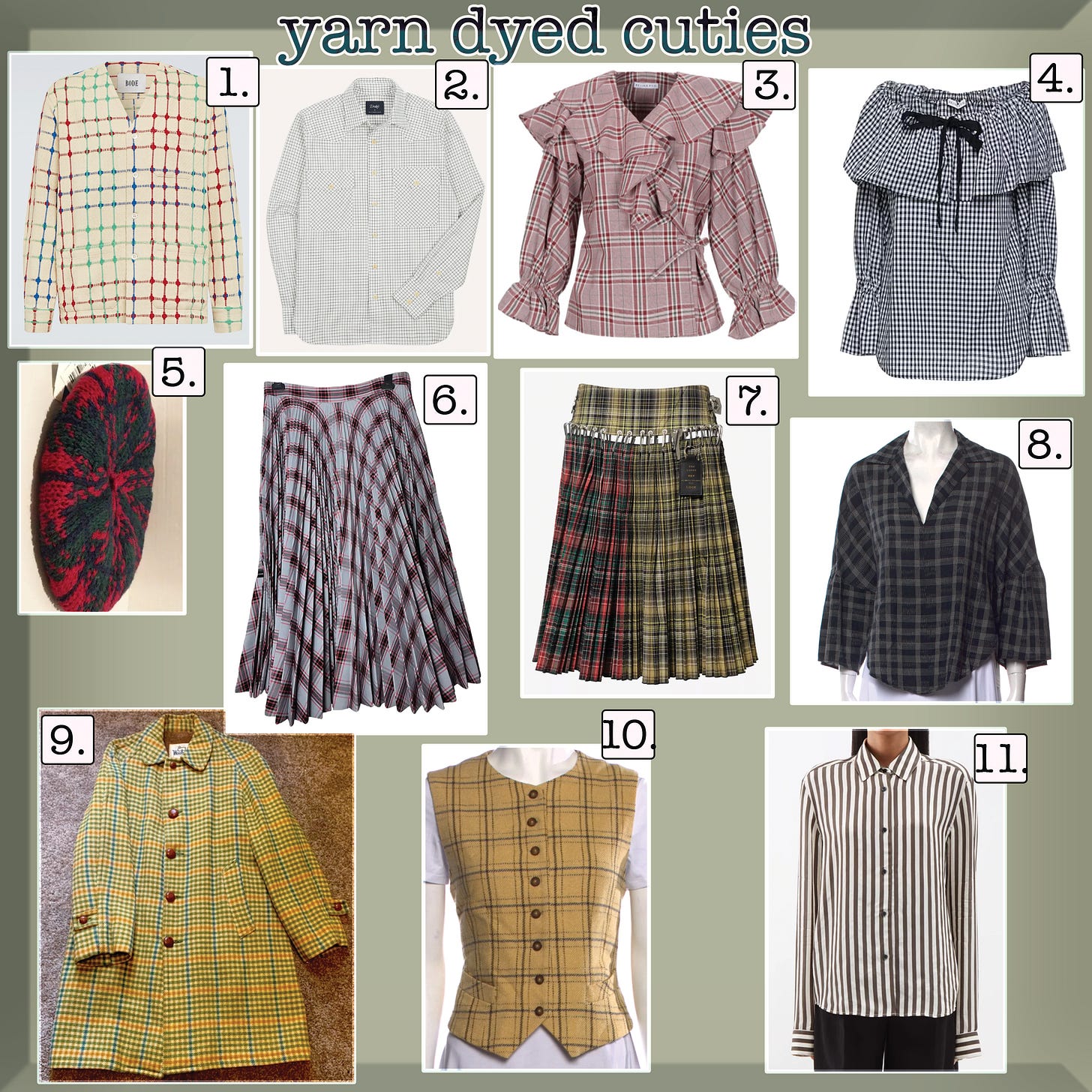Stripes, checks & plaids--oh my! A love letter to yarn dye mixing.
It's a yarn dyed patterned fabrics feature bonanza.
How many yarn dyes can one outfit hold?
This week, I aimed to find out. But I can assure you I was not able to exceed the extensive yarn dyes found in HBO’s Deadwood—That show seriously has the best inspo for plaids, tattersalls, checks, and stripes.
Anyhow, if you feel you’re outgrowing the wearing of prints, welcome to my style-psyche for the last few years. As I’ve gotten older, I connect less and less with conversational prints or at least prints that aren’t deeply classic; like a lovely floral, neutral leopard print, or even a perfect polka dot (all of which can actually be woven, not just printed; however we’re not covering jacquards today). But there’s a big part of me that will always be drawn to pattern mixing and having the choice to wear non-plain-surface garments. So as I’ve navigated this maturation of my own taste, I’ve realized that yarn dyes offer the best of both worlds: a non-solid option and a time-honored look.
Yarn dyes, after all, are like the first ever “prints”—even though the fabric is not printed; the yarns or threads are dyed before weaving or knitting, creating a pattern. I touched on yarn dyed fabric in shirting because I have a hate on for fake sh*t, and this includes when brands mimic the (more expensive) woven-in yarn dye look with a printed stripe or plaid, etc.; printing is cheaper than weaving together (or knitting) different colored yarns.There are of course ways to do abstract ginghams or stripes in which case, the fabric is printed to allow for an artistic and intentionally-uneven stripe, for instance. My Jacquemus top worn in Puerto Rico is a great example of a watercolory-look printed gingham.
To illustrate my point further, take a striped button-down: it looks so weird (and cheap) to see the stripes visible on the outer side of the fabric and clearly less so on the under side, i.e. when you fold up your shirt cuffs (yes, my love of beautiful clothing insides extends to fabric treatments, too).

While you can yarn dye any weave (i.e. chambray or denim), let’s hone in on yarn dyes that create patterned textiles for this edition of the CRACD textile dossier. The most common multicolor patterned yarn dyes worn today in the western world, excluding jacquard weaves are: stripes, plaids+tartans, ginghams+checks, houndstooths+herringbones, tattersalls+window panes, and, I’m throwing dobby weaves in there even though they’re less prevalent because they’re so damn cute. You can also knit in a patterned fabric for a cut-and-sew garment (think Breton stripe), or fully fashioned motif in a sweater (think plaid intarsia); and this method is always superior to a printed knit. Don’t even get me started on printed—literally printed on the surface—sweaters, yuuuuckkk….
Twill you remember twill, and may I speak plainly about plain weaves?
Plus revisiting tartan and plaid.
But back to wovens for now: a yarn dye implies *sorry* only one part of the weaving process and that is of course the dyeing of yarns. What precedes and follows yarn dyeing—during the fiber collection & weaving processes—call the shots for the fabric’s final features. If you’re a total nerd then you may recall tartan is a twill weave (it is also a yarn dye). Twill is created when “each thread passes first over two and then under two of its crosswise counterparts. This produces a ribbed, diagonal effect on the length of the material.” (pg. 15 of The Complete Book of Tartan, (2004)). Again, if you’re a textile nerd—or maybe just an amazing-rememberer—denim is the most well-known of twill weaves. That diagonal ribbing effect is most visible in denim due to the use of cotton yarns, which are shorter than other fibers, and the ratio of 3/1 indigo/white yarns.

Though I believe twill weaves bring style-joy beyond just denim, especially in the world of patterned yarn dyes. A wool plaid or tartan twill, for example, is the ultimate classic for skirts and winter shirting. So an easy way to exclude printed tartan or plaid from your online search is to type “plaid twill”; the inclusion of the actual weave (twill) helps direct garment options shown from fabric-serious sellers, who know the difference between printed versus woven-in fabric designs.

Plain weaves make up one of the big three textile fundamentals; the other two are twill and satin. Plain weaves are strong with a smooth, flat surface. The warp and weft threads cross at right angles in plain weave cloth, making up a simple criss-cross design. Believe it or not: a basket weave can be used in clothing and is a variation of the plain weave, where it’s typical for two or more warp and weft threads to cross one another (instead of one each way, like a normal plain weave). So if you’re looking for an extra flat, sturdy and starchier yarn dyed garment, keep an eye out for that criss cross pattern.
A window to your clothes: Tattersalls & window panes.
I’m devastated to not own a single tattersall yarn dyed piece, so I’ll be adding that to my ongoing wish list. Tattersalls and window pane weaves are most typically made into cotton shirting, and they can be woven as a twill or plain weave. The two can be differentiated from one another by the fact that window panes use only one color in the “panes”, and tattersalls use two or more colors in the panes/checked pattern. The tattersall pattern is composed of regularly-spaced thin, even vertical warp (longitudinal) stripes, repeated in the weft (latitudinal), thereby forming squares. Historically, tattersall was worn in the English countryside. The rural roots of the fabric quickly inspired its use in American western-wear (hence why so much tattersall is seen in Deadwood).
The checks family gives you no [negative] space.
Get on the grid: ginghams & checks.
Ginghams and checks can be woven as plain weaves or twills, with the most notable difference between these two being: gingham uses two colors (one is always white), and checks use more than two colors. A cotton gingham plain weave fabric is most memorable in the form of a picnic blanket: starchy, flat, bi-colored with white as one of the two crossing colors. Records on gingham date back to the 17th century when England imported gingham fabric from France; although the weave is said to have been used much earlier and called by another name in Malaysia. Like I often say with original intent/use for clothes making for great inspiration for current styling (aka lean into the cliché), I think gingham worn in a very literal spring/summer French beach way is adorable, so get after some gingham and be your own picnic blanket.
Howsabout those houndstooths & herringbones?
Similar in structure and design to ginghams+checks are your houndstooths and herringbones. Herringbone traces back to ancient Roman times (true to the Classical Era), using signature repeated chevrons. Side note: does anyone else find that it can be a little dizzying to stare too hard at a herringbone lol? Given the diagonal direction of herringbone, it is most often found in the twill weave family, woven as a tweed fabric: rough, woolen, soft with an open structure and homespun; most commonly seen in outerwear. Not to overwhelm you but tweed implies the pre-weaving process; so you can actually have a fabric that is all of these: tweed, twill, AND herringbone.
Houndstooth is also hella old, originating as a unique tartan (which, remember, is a twill) of the Scottish lowlands between 360 AD - 100 AC; although houndstooth is believed to have been created by a non-clansman. Houndstooth’s trademark jagged outlined edge along the checks gives it its name; as this shape is reminiscent of a hound dog’s tooth. You’re likely most familiar with houndstooth in high-contrast black and white—late 1980s-’90s fashions loved to overdo it with large scaled black/white houndstooth fabrics (this trend was revisited in the 2010s which is maybe why I’m still scarred by it).
I recommend trying out a houndstooth or check in a neutrals or Earthy color palette. Black & white may sound easy to wear but it can actually feel really limiting because the high contrast is so jarring (and sometimes difficult to pair back with color), especially when in addition to the unleveled visual of pointy-edged houndstooth. Also, as far as pattern scale goes: I like my plaids to be big and my houndstooths, checks, and herringbones smaller. I find that, given anything in the checks family contains no negative space, styling smaller-scale checks back with larger-scale plaids (which use negative space in their designs), is a surefire combination to keep pattern mixing grounded.
Who doesn’t like stripes?
Stripes! Need I say more? Although, since I’ve given a little history on each textile so far, why stop now? You need to know that stripes were originally deemed a sign of the devil in Medieval times lol. It wasn’t until Queen Victoria chose to clad her son in vertical and horizontal stripes as part of a nautically-striped sailor suit for a royal outing that the pattern launched into fashion for the high class. It is my opinion that of all the patterned yarn dyes discussed today, stripes are the easiest to wear; given their open-space visual, they pair smoothly with plaids and checks.
Dobby weaves (nothing to do with the elf).
Dobby fabric is a type of woven fabric produced on a specialized loom, called the dobby loom. The dobby cloth weaving technique dates back to the 1840s, wherein the weaver was able to raise and lower the warp (vertical) threads individually. Dobby weaves come in a vast assortment and are more rare. Due to dobby cloth’s array of designs, they can can be difficult to identify, but you can usually spot dobby fabric by its distinguished geometric pattern that has a raised texture wherever the pattern is located. The backside of the fabric also includes “floats” which are open/loose-looking threads, located behind the pattern design areas. A swiss dot fabric is the most typical of dobby weaves, which I do not personally own, but I do have a teenie-scale Dobby cloth Tome shirt (worn in first outfit pic), and half of my Chopova Lowena skirt (in third outfit pic) is a dobby weave (the box pleated part).

Due to the delicate nature of dobby weaves and the unique, more limited looms they require, the fabric is extra special and expensive. You can create raised texture stripes using dobby looms; the most eminent example of this comes in the form of a garment called the “Baja Hoodie” or “drug rug”. Who knew that slubby, striped fabric was so dang exclusive?
The most fun takeaway from all this patterned yarn dye fabric knowledge: you can mix them all. I got to four yarn dyed patterned fabrics in total for one outfit, but I’m sure I could stack more plaids if given the chance (I need to get some plaid stockings).
Lastly remember that fabric weaves are only a piece of the whole pie; you need to know the fiber content (of what the fabric is composed), too, and make sure to go for natural fibers (from animal, mineral or vegetable) whenever you can.
Drake’s cotton tattersall twill two-pocket shirt made in England $345
Second hand Rejino Pyo (same as mine) wrap ruffle cotton plaid plain weave top sz S $225
Rejina Pyo (same as mine) cotton gingham plain weave bow-neck ruffle top $117
Vintage Pendleton wool fully fashioned plaid intarsia beret (similar to mine) $45
Chopova Lowena (same brand as mine, different style) cotton tartan mix midi skirt $1,090
Second hand Tome (similar to mine; different dobby fabric & without neck ruffle) tent top sz S $33
Thus ends this edition of the textile dossier. Also a heads up, I will be moving CRACD to a bi-weekly schedule for the next little while because I need the time and energy to get some design and development completed for Villeine. Keep an eye out for exciting new stuff to come! xHannah









I will forever love ginghams. I had the most stupendous paneled swirl skirt in 9th grad that I sewed. It had purple, orange, magenta and yellow and I couldn’t even count all the compliments I got every time I had it on. Truly one for the ages—if only I still owned it.